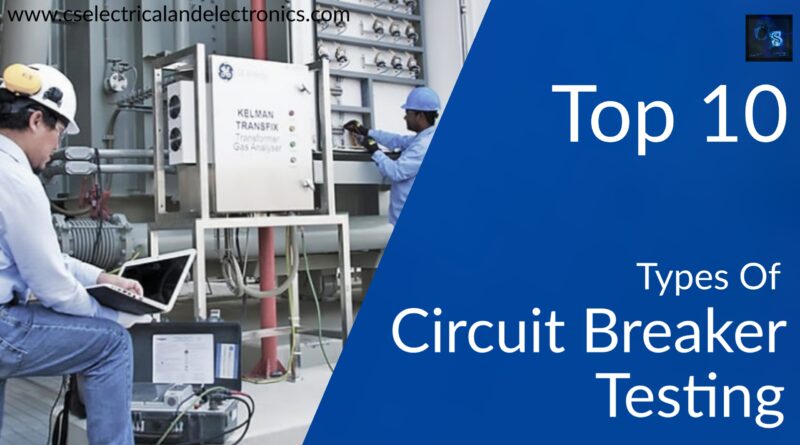Circuit Breaker Testing, Top 10 Types Of Testing On Circuit Breakers
Hello guys, welcome back to my blog. In this article, I will discuss the top types of testing on circuit breakers or circuit breaker testing, why it is conducted, the benefits of circuit breaker testing.
If you have any doubts related to electrical, electronics, and computer science, then ask questions. You can also catch me @ Instagram – Chetan Shidling.
Also, read:
- Difference Between Hydrogen And Lithium, Future Of Electric Vehicle
- What Is Reactor, Types Of Reactors Used In Power Systems, Applications
- Top 10 Amazing Autonomous Vehicles Makers That Will Attract You
Circuit Breaker Testing
It is conducted to ensure that the circuit breaker works efficiently under all conditions. Before using a circuit breaker at different places there are many tests conducted on it, such as:
01. Mechanical Test
It’s a mechanical ability test in which the breaker is repeatedly opened and closed. A circuit breaker must close and open at the correct rate and perform its assigned duty and function without fail.
02. Thermal Test
Circuit breakers are subjected to thermal tests to determine their thermal behavior. Due to the streaming of rated current through its pole in a rated condition, the breaker under test exhibits steady-state temperature rises. The temperature rise for rated current should not exceed 40° for normal currents less than 800A and 50° for normal currents 800A and above.
03. Dielectric Test
The purpose of this test is to determine the power frequency and impulsive voltage withstand capabilities. On a new circuit breaker, power frequency tests are retained, the test voltage varies with the circuit breaker’s rated voltage. In impulse testing, a certain value of impulse voltage is applied to the breaker. Outdoor circuits are subjected to both dry and wet testing.
04. Short-Circuit Test
In short-circuit test laboratories, circuit breakers are subjected to abrupt shortcircuits, and oscillograms are obtained to determine the behavior of the circuit breakers at the moment of switching in, during contact breaking, and after the arc extinction. The producing and breaking currents, as well as symmetrical and asymmetrical restriking voltages, are analyzed in the oscillograms, and switchgear is occasionally tested in underrated settings.
05. Circuit Breaker Trip Test
It is feasible to identify whether there are mechanical or electrical concerns present by analyzing the current utilized by the trip coil during the circuit breaker’s operation. In many circumstances, such problems may be pinpointed to help in the discovery of the main cause. Detecting issues with tripping batteries can be done by monitoring the voltage of the tripping supply during the operation.
06. Insulation Resistance Test
Load and line conductors should be separated for individual breaker resistance testing. If the test readings aren’t separated, they’ll additionally include the features of the linked circuit. To guarantee that the insulating material that makes up the molded case breakers is operating correctly, resistance testing is required. Equipment called a megger is used to test for insulating resistance.
A megger instrument tests the resistance within the insulation on a specific wire or winding by applying a specified DC voltage to it for a set amount of time. When there are no reports of potential changes, it is critical to use voltage since the resistance measured with an ohmmeter may differ. It should also be noted that if you apply a voltage that is more than the insulation’s ability to bear, the insulation may be damaged.
07. Connection Tests
Connection testing is necessary to ensure that a suitable electrical connection is present and to identify overheated traces indicated by a color difference. To avoid and decrease overheating, electrical connections to the CB must be correctly fitted.
08. Contact Resistance Test
After prolonged use, normal wear and tear of contacts within the CB occur. Quantifying the resistance across each pole of the circuit breaker is a simple way to find evidence of weakening inside the breaker. If there are significant millivolt dips across the breaker, this indicates abnormal conditions within the CB, such as contact erosion and contamination. The contact resistance test is crucial for determining whether or not a circuit breaker is still functional.
09. Overload Tripping Test
Check for overload tripping components of CBS by putting 300 percent of the breaker rating into each pole of the circuit breaker and seeing if it opens right away. The goal is to determine whether or not the circuit breaker will activate. For permissible trip times for the overload tripping test, consult the NETA guidelines. It is best to reference the manufacturer’s instructions while trying to figure out tripping characteristics.
10. Instantaneous Magnetic Tripping
Instead of determining the precise value at which the instantaneous magnetic feature performs, it is more important to determine if the magnetic feature is functional and will trip the circuit breaker during normal tests.
Benefits of Circuit Breaker Testing
- On-site performance is quick and simple.
- Circuits can be checked both with and without a load.
- The performance of the entire tripping cycle is evaluated.
- The total timing of the tripping system is tested.
- Determines the necessity for maintenance.
- It’s all part of a larger diagnostic maintenance routine.
- Find early warning signs of potential issues.
- Other than picking up pieces, stay away from them.
- Create a database of test records for trending.
- Identify the negative performers
To summarise, Circuit Breaker Testing is used to evaluate the performance of each switching system as well as the programming of the overall tripping system. Circuit breaker testing is necessary to guarantee that this critical link in the power asset chain operates safely and reliably
I hope this article may help you all a lot. Thank you for reading.
Also, read:
- 10 Tips To Maintain Battery For Long Life, Battery Maintainance
- 10 Tips To Save Electricity Bills, Save Money By Saving Electricity
- 100 (AI) Artificial Intelligence Applications In The Automotive Industry
- 100 + Electrical Engineering Projects For Students, Engineers
- 1000+ Control System Quiz, Top MCQ On Control System
- 1000+ Electrical Machines Quiz, Top MCQs On Electrical Machines
- 1000+ MATLAB Simulink Projects For MTech, Engineering Students
- 50 Tips To Save Electricity At Home, Shop, Industry, Office
Author Profile
- Chetu
- Interest's ~ Engineering | Entrepreneurship | Politics | History | Travelling | Content Writing | Technology | Cooking
Latest entries
 All PostsApril 19, 2024What Is Vector CANoe Tool, Why It Is Used In The Automotive Industry
All PostsApril 19, 2024What Is Vector CANoe Tool, Why It Is Used In The Automotive Industry All PostsApril 13, 2024What Is TCM, Transmission Control Module, Working, Purpose,
All PostsApril 13, 2024What Is TCM, Transmission Control Module, Working, Purpose, All PostsApril 12, 2024Top 100 HiL hardware in loop Interview Questions With Answers For Engineers
All PostsApril 12, 2024Top 100 HiL hardware in loop Interview Questions With Answers For Engineers All PostsMarch 22, 2024Driver Monitoring Systems In Vehicles, Working, Driver Sleepy Alert
All PostsMarch 22, 2024Driver Monitoring Systems In Vehicles, Working, Driver Sleepy Alert








